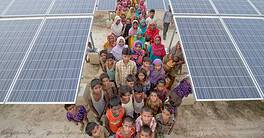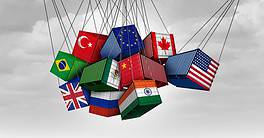Melissa Frakman, CEO and founding partner of Emphasis Ventures, a global early-stage venture capital firm that focuses on India, speaks with Global Finance about digital infrastructure and fintech trends in what some economists believe will soon be the world’s third largest economy.

Global Finance: You’ve said that what’s happening today in India is one of this decade’s most important economic stories: as important as China’s rise during the 1990s and 2000s. What’s happening in India that’s so unique?
Melissa Frakman: There’s this global trend of digital public infrastructure (DPI) that’s emerging, of which India has become the unequivocal leader: implementing national digital systems at scale that are free or low-cost and accessible to the poor.
It started when India built Aadhaar, its biometric ID system, more than 10 years ago. Various layers of infrastructure were built on top of it in the past decade, including payments—with a know-your-customer layer—and a health stack for health records and medical aimed at expanding medical care accessibility, among other things.
GF: This innovation is benefiting the people of India—not just exporters, say?
Frakman: Of course, inequality persists in India. There is still a massive wealth disparity that by all accounts is not decreasing now: which is a problem.
But consider the public nature of this infrastructure: the fact that the biometric ID system is for 1.4 billion people, and it is free and interoperable, which means any software developer can plug into it and build on top of it. The same with payments: it’s unlocked. Even the most remote poor person in India is able to access digital payments in a way that those at the bottom of the pyramid in the US cannot.
GF: Can you tell us more about the Indian model with respect to payments?
Frakman: India’s real-time payments network is called UPI: Unified Payments Interface. Imagine PayPal, Visa, First Data, etc., all combined and free for a billion people: biometrically enabled and doing more transactions per year than Visa. It’s easy to use. I could buy you a coffee by transferring payment from my bank account to yours using my thumbprint.
An interesting note: Some of the companies that have built applications on top of this public digital platform are global companies, including Walmart-owned PhonePe, arguably the largest consumer app for payments. Paytm is another leader in this space, and Google Pay has made incredible strides.
GF: India Stack—the country’s unified software platform—has had a dramatic impact, and regulation has undoubtedly played a big part in pushing payments. But how likely is the Reserve Bank of India (RBI) to get the right balance as it establishes a regulatory structure for fintechs?
Frakman: The technology is moving at such a fast pace that it’s nearly impossible to hold the regulators to the standard that they nail the exact balance at the same pace as the tech is moving. That said, the RBI is a great regulator in terms of taking their market development and industry support functions seriously.
There have been a lot of new, controversial fintech regulations that have come out recently. Our view is that this is increasing predictability, and it’s a net positive in terms of having more transparency in the market.
GF: How does India’s commitment to digital public infrastructure compare with other countries’ efforts in this area: China’s, for instance?
Frakman: In China’s system, the private sector is the core interface for these stacks. WeChat is still the super app on which all these things like payments happen.
The big difference in the DPI that’s coming out of India—or even the India-like models that countries in Africa and across Latin America are now adopting—is the “p”: the “public” part of it. These are national systems from day one. They are not being built to serve any specific private sector entity. They put consumer access at the forefront.
GF: India today is on track to be the third largest global eco-nomy by 2030, according to some economists. Given its commitment to a public digital infrastructure, could India surpass China economically one day?
Frakman: India has a really long way to go in just bringing up the overall economic prosperity of its population. That’s more than technology alone can do. But I do see a trend of global companies emerging. We think that some of the next Apple-sized companies over the next few decades will come out of India. But in terms of pure GDP power, I don’t know whether India will surpass China this century, or the next.
GF: Other regions, like Central America and the Caribbean, face issues similar to India’s regarding banking the unbanked, and sustainable agriculture, among others. What can these regions learn from India?
Frakman: Smaller economies can look to India for fintech mo-dels that actually work when the transaction size is small or when per-user revenue is small.
One example is Khatabook. It’s a micro app that works on a simple phone with micro or small businesses with low data needs: from a manufacturing business with 30 or 50 employees to a single person like a chai seller. They are enabled to do all the tracking of transactions and accounting and everything else they need to do on their phone. And Khatabook has been able to scale to every remote part of India. Well over 10 million micro and small businesses are using it.
Khatabook was able to scale so quickly because it was so simple, and it was tailored to what actually is needed. It was not trying to replicate what a large bank or a large accounting stack would use.
GF: It’s hard not to talk about politics. A lot of progress is arguably being made under Prime Minister Narendra Modi’s government in the fintech sector. But this remains a relatively authoritarian government. Could the same degree of progress in innovation be achieved under a less harsh leadership?
Frakman: The reason that fintech has really taken off in India is due to a confluence of factors, beginning with a tech boom in the 1990s, the era of TCS and Infosys and Wipro. The RBI has been a very independent regulator and has stayed consistent in its support of the sector throughout, even with various political leadership changes.
I would say that most of this fintech development has very little to do with politics in India. It’s more about the economic trajectory for adoption where investment and technology opportunities open up, and also where global companies have seen opportunities to invest.
GF: You earlier described India’s banking system as “mature”; some may have a different image. We don’t see Indian banks active on the international scene, for instance.
Frakman: I can’t speak for HDFC Bank [India’s largest private-sector bank], but I would venture to guess that it’s because there’s so much untapped opportunity domestically that there’s almost no reason to go abroad.
That being said, Indian banks—the largest private-sector ones—have major aspirations to continue to internationalize. And I think we will see their foray into that in the coming years, especially in partnership with fintechs.
GF: Given its large unbanked population, is India likely to adopt a digital currency?
Frakman: India has been moving toward launching a central bank digital currency—a digital rupee—that will help to further internationalize the rupee.
However, as relates to crypto in the Indian market and other kinds of private digital currencies, we do not anticipate much change in the next few years. We think it will be more than five years before any opportunity emerges for crypto building and trading domestically.
There has been a lot of homegrown talent in the crypto sector in India that has ended up building businesses in other markets, including Polygon in the US.
But in India, some of these things we’re talking about, like UPI, have served a goal similar to digital currency in other markets. It is expanding financial inclusion for the unbanked and bringing in a sort of digital transparency.



